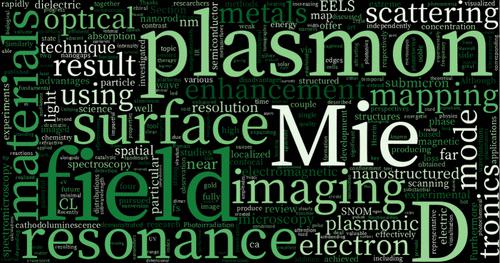当前位置:
X-MOL 学术
›
J. Phys. Chem. C
›
论文详情
Our official English website, www.x-mol.net, welcomes your feedback! (Note: you will need to create a separate account there.)
1D, 2D, and 3D Mapping of Plasmon and Mie Resonances: A Review of Field Enhancement Imaging Based on Electron or Photon Spectromicroscopy
The Journal of Physical Chemistry C ( IF 3.7 ) Pub Date : 2024-03-22 , DOI: 10.1021/acs.jpcc.3c07393 Ken-ichi Saitow 1, 2, 3
The Journal of Physical Chemistry C ( IF 3.7 ) Pub Date : 2024-03-22 , DOI: 10.1021/acs.jpcc.3c07393 Ken-ichi Saitow 1, 2, 3
Affiliation

|
Localized surface plasmon resonances of nanostructured metals and Mie resonances of submicron-structured semiconductors couple with electromagnetic waves, producing extreme light concentration. These phenomena have led to the development of plasmonics and Mie-tronics, and the volume and quality of fundamental research, novel techniques, and applications in these fields is increasing. Thanks to technological progress, localized surface plasmon resonances can be imaged with high spatial (>0.05 nm), energetic (>0.05 meV), and temporal (0.2 fs) resolutions using three modalities: cathodoluminescence (CL), electron energy loss spectroscopy (EELS), and scanning near-field optical microscopy (SNOM). In addition, Mie resonances, which occur in larger-sized dielectric materials with low electric conductivity (i.e., submicron-structured semiconductors), can be imaged using a far-field confocal spectromicroscopy. Although there have been various landmark surface plasmon and Mie resonance imaging results based on both electron and optical spectromicroscopy techniques, so far, perspectives have been focused exclusively on one topic or the other. Moreover, Mie-tronics is a rapidly expanding field, but there are no published reviews of Mie scattering/resonance mapping experiments. A combined overview of the mutually relevant fields of both optical and electron spectroscopic imaging should provide important insights. Furthermore, direct comparisons between plasmonics and Mie-tronics studies are valuable from the viewpoints of physical chemistry and materials science. Herein, representative state-of-the-art localized surface plasmon and Mie resonance mapping results obtained using four imaging modalities─CL, EELS, SNOM, and far-field confocal spectromicroscopy─are described, and the advantages and disadvantages of each, together with future perspectives, are discussed.
中文翻译:

等离激元和米氏共振的 1D、2D 和 3D 映射:基于电子或光子光谱显微镜的场增强成像综述
纳米结构金属的局域表面等离子体共振和亚微米结构半导体的米氏共振与电磁波耦合,产生极端的光集中。这些现象促进了等离激元学和微电子学的发展,这些领域的基础研究、新技术和应用的数量和质量不断增加。由于技术进步,局域表面等离子体共振可以使用三种模式以高空间(>0.05 nm)、高能(>0.05 meV)和时间(0.2 fs)分辨率成像:阴极发光(CL)、电子能量损失光谱(EELS) )和扫描近场光学显微镜(SNOM)。此外,可以使用远场共焦光谱显微镜对大尺寸低电导率介电材料(即亚微米结构半导体)中发生的米氏共振进行成像。尽管基于电子和光学光谱显微镜技术已经出现了各种具有里程碑意义的表面等离子体和米氏共振成像结果,但到目前为止,观点仅集中在一个主题或另一个主题上。此外,米氏电子学是一个快速发展的领域,但目前还没有关于米氏散射/共振映射实验的公开评论。对光学和电子光谱成像相互相关领域的综合概述应该提供重要的见解。此外,从物理化学和材料科学的角度来看,等离激元学和微电子学研究之间的直接比较是有价值的。本文描述了使用四种成像方式(CL、EELS、SNOM 和远场共焦光谱显微镜)获得的代表性最先进的局域表面等离子体和米氏共振图谱结果,以及每种成像方式的优缺点,以及未来的前景,进行了讨论。
更新日期:2024-03-22
中文翻译:

等离激元和米氏共振的 1D、2D 和 3D 映射:基于电子或光子光谱显微镜的场增强成像综述
纳米结构金属的局域表面等离子体共振和亚微米结构半导体的米氏共振与电磁波耦合,产生极端的光集中。这些现象促进了等离激元学和微电子学的发展,这些领域的基础研究、新技术和应用的数量和质量不断增加。由于技术进步,局域表面等离子体共振可以使用三种模式以高空间(>0.05 nm)、高能(>0.05 meV)和时间(0.2 fs)分辨率成像:阴极发光(CL)、电子能量损失光谱(EELS) )和扫描近场光学显微镜(SNOM)。此外,可以使用远场共焦光谱显微镜对大尺寸低电导率介电材料(即亚微米结构半导体)中发生的米氏共振进行成像。尽管基于电子和光学光谱显微镜技术已经出现了各种具有里程碑意义的表面等离子体和米氏共振成像结果,但到目前为止,观点仅集中在一个主题或另一个主题上。此外,米氏电子学是一个快速发展的领域,但目前还没有关于米氏散射/共振映射实验的公开评论。对光学和电子光谱成像相互相关领域的综合概述应该提供重要的见解。此外,从物理化学和材料科学的角度来看,等离激元学和微电子学研究之间的直接比较是有价值的。本文描述了使用四种成像方式(CL、EELS、SNOM 和远场共焦光谱显微镜)获得的代表性最先进的局域表面等离子体和米氏共振图谱结果,以及每种成像方式的优缺点,以及未来的前景,进行了讨论。



























 京公网安备 11010802027423号
京公网安备 11010802027423号